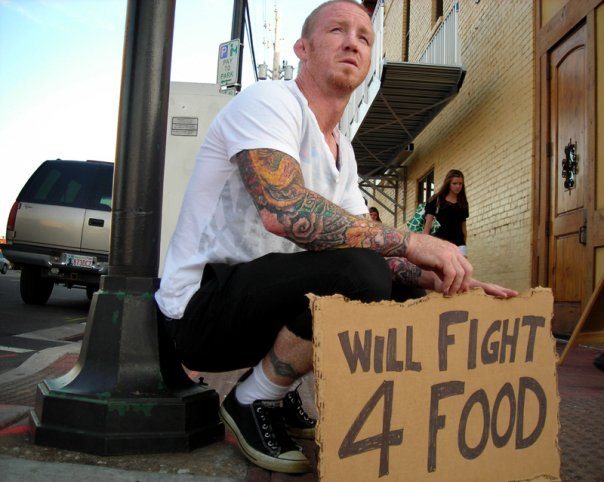This post may contain affiliate links to products or services which, if you purchase, may result in my earning commissions at no additional cost to you.
MMA is the fastest growing sport in the world. Most of this rapid growth has come during the middle of the worst recession in recent history. It is interesting that during the past 4 years since the recession started it is estimated that the UFC has tripled in size – part of this growth was through acquisition but most of it was done through expansion of pay-per-view (PPV) and fight frequency. In other words more people were watching (and paying) to see fights on TV, more people were paying to see fights live at the arena and they were doing this at an increased frequency (more fights every month) – all of this during a time when people had fewer dollars to spend. What is it about watching people punch, kick and grapple with each other that makes it so easy for us to part with our money when it’s so hard to hang on to normally?
During this recession we have seen several UFC fights which have broken records; record attendance (GSP vs. Shields), record number of sell-out crowds, record viewership, record payouts to individual fighters, record total purses (all fights combined) and at the same time there is a record amount of consolidation in the industry (WEC & Strikeforce purchased by the UFC). The other phenomenon during this time is that there is an ever increasing number of fighters paying to enter the gyms and hit the mats to train to be the next champion.
On a local level, we’ve seen multiple companies try to catch this wave. We have seen several gyms open recently that specialize in BJJ, MMA, Boxing or Kickboxing. And I can count at least 5 new fight promotions (organizations) which have started just within the past year since I’ve been active in the NM fight community. Related businesses are expanding (fight gear, apparel, food, and other entertainment) at an ever increasing rate as well.
It’s easy for a casual, and uneducated, fan to look at the money in the sport and think they understand why someone would want to be a professional fighter. A look at Jon Jones’ payout from his last fight in Las Vegas (Nevada is one of the few states that publically reports fighter payout amounts) – UFC 126 against Ryan Bader – and you see that he earned $384 for every second of the fight ($215,000 including submission of the night bonus)! Of course we all understand that there were years of preparation to get to that level in the sport but the size of the payout is incredibly enticing especially to someone growing up where fighting is their only option (recall the conversation with Damacio Page that helped to start KNUXX) especially during an economic depression.
The gyms in New Mexico are full of incredibly talented fighters who are pulled by the dream of making it to the ranks where they can experience financial freedom. MMA practitioners, boxers, grapplers, kickboxers and traditional martial artist all make their way to the gyms each week. They are driven by the desire to excel in the sport and be the best fighter in their division, but most of them were initially enticed by the money that can be made – it’s a way for them to change their personal and familial economics. If they fight well, train hard, and get a little luck they have the potential to be able to provide a better life for themselves and those around them – fighting can literally help them fight their own history and future. Carlos Condit recently told KNUXX that part of the reason he fights now is to give his son something to be proud of and to also give him opportunities that he [Condit] didn’t have growing up.
MMA’s rapid increase in popularity during a recession, I think, has more to do with psychology than it does economics and money. Sure, MMA is a new sport and has only started to come into its own over the past 5-6 years as it gains more mainstream popularity, but the appeal is deeper than that. Due to the economy, people already have a feeling of being beat down and stomped on. Most keep getting up each day and keep fighting and trying. Watching a UFC event is more than just an entertaining distraction, it’s a metaphor for real life, right now, today and the battle we are facing. People get a feeling of comfort, or empathy, when they see someone stand in a cage and fight for their life. What does this mean for the long term? When we “recover” will MMA lose its appeal? One has only to look to boxing for an answer.
During this same period we have seen some RIDICULOUS amounts of money being paid in boxing ($36 million for the last Mayweather fight)! Boxing has long been the poster child for insanely high purses – it has also been the long-standing example of a recession-proof industry. Since its history is so long you can chart the correlation between recessions and boxing popularity – it may not come as a surprise that boxing has not just survived but has thrived during the past several recessions. Even in hard times, the fighter payouts might have been lower, but the overall industry did really well. It seems that people were willing to pay to see people beat each other up even when they didn’t have a lot of money to spend. And post recession the sport always did better than it did before the dips.

What does this all mean? I think it means that MMA will have a similar path that boxing has followed for many years. There will room to make money whether the economy is good or bad. There will be room for new fighters at all levels. There will be a need for ancillary products and services during this time and there will still be money flowing in the sport – money for fighters to live, grow, change and succeed – money for businesses to sustain themselves through the hard time – and money available to keep combat sports growing and continuing to Fight the Economy.



